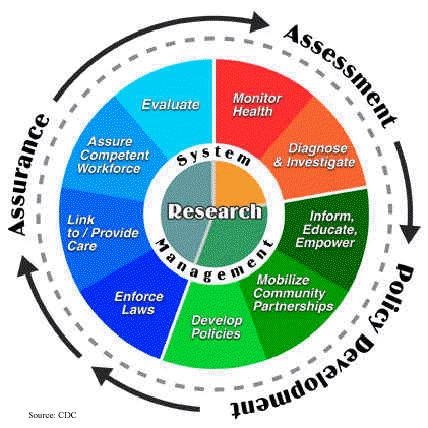Strengthening New York's Public Health System for the 21st Century
REPORT OF THE PUBLIC HEALTH INFRASTRUCTURE WORK GROUP TO THE PUBLIC HEALTH COUNCIL
III. DEFINITION OF TERMS
A. Definition of Public Health
The Work Group used a public health definition statement prepared by a member of the Work Group, Kristine Gebbie, Dr. PH, RN as a point of reference.
"Public Health is the set of organized community efforts that fulfill society's interest in assuring conditions in which people can be healthy by applying scientific and technical knowledge to prevent disease and promote health. The goal of public health is to improve the health status of the population, with careful attention to and respect for the perspectives and values of the diverse members of the community being served. There is a public health system in each community defined as the wide range of public, private and voluntary organizations such as governmental agencies, academia, health care providers, hospitals, community-based organizations, associations, businesses and individuals. The unique function of governmental public health agencies within this broad infrastructure framework is to see that all vital system elements are in place; that all core functions and essential services (see below) are coordinated; and that the mission of improving the health of the community is adequately addressed, using if necessary, the regulatory powers of the state."2
B. Specific Responsibilities of the Public Health System
The specific responsibilities of the entire public health system are to:
- Prevent epidemics and the spread of disease
- Protect against environmental hazards and prevent injuries
- Promote and encourage healthy behaviors
- Assure the quality and accessibility of health services
- Respond to disasters and assist communities in recovery3
C. Core Functions
The core functions of public health agencies that must be carried out at all levels of government for the overall public health system to function effectively include:
- Assessment: regular, systematic collection, assembly, analysis and distribution of information on the health of the community, including statistics on health status, community health needs, and epidemiological and other studies of health problems;
- Policy development: using the scientific knowledge base in decision-making about public health and taking a strategic approach to leadership for public health policy with a positive appreciation for the democratic political process;
- Assurance: engaging policy-makers and the public in determining those services that will be guaranteed to every member of the community, and making services necessary to achieve agreed-upon goals available by encouraging action by public and private entities, implementing regulatory requirements, or directly providing services.4
D. Ten Essential Public Health Services
The ten essential public health services derive from the specific responsibilities and core functions and form the basis of all public health programs. The Work Group shares the view of the Institute of Medicine (IOM) that all communities should have access to these ten essential public health services.5
- Monitor health status
- Diagnose and investigate health problems and health hazards
- Inform, educate and empower people about health issues
- Mobilize community partnerships to identify and solve health problems
- Develop policies and plans that support individual and community health
- Enforce laws and regulations that protect health and ensure safety
- Link people to needed personal health services and assure the provision of health care when otherwise unavailable
- Assure a competent public health and personal health care workforce
- Evaluate the effectiveness, accessibility and quality of personal and population-based health services
- Conduct research for new insights and innovative solutions to health problems6
The Public Health Wheel best illustrates the relationship among core functions, specific responsibilities and the ten essential public health services.
Figure 1
Public Health Wheel

E. Public Health Infrastructure
The public health infrastructure provides the platform on which the ten essential public health services and programs can be built and is comprised of:
- Public Health Workforce: Those persons responsible for providing essential public health services regardless of the organization in which they work, who are competent to perform public health functions and assure the delivery of essential public health services;
- Public Health Organizational Systems and Relationships: The organizational network that links governmental public health at federal, state and local levels together with all other key infrastructure partners (e.g. legal and organizational structures of governmental public health, intergovernmental agreements, organized coalitions, community partnerships, funding streams); and
- Public Health Data and Information Systems: The knowledge and management of health status, health resources and threats to health specific to the jurisdiction or community of interest (e.g. health statistics, public health surveillance of reportable diseases, environmental monitoring, health services statistics, community resources inventories).7
The Work Group focused much of its review on the strengths and needs of these components of the public health infrastructure at the local level in New York State.
2 Adapted from The Future of Public Health, Institute of Medicine, National Academy Press, 1988.
3 Adapted from Public Health in America, Public Health Functions Steering Committee, US Department of Health and Human Services, 1994.
4Adapted from The Future of Public Health, Institute of Medicine, National Academy Press, 1988.
5 The Future of the Public's Health in the 21st Century, Institute of Medicine, National Academy Press, 2002
6 Public Health in America, Public Health Functions Steering Committee, US Department of Health and Human Services, 1994.
7 Adapted from Healthy People 2010, US Department of Health & Human Services, 2000. 11